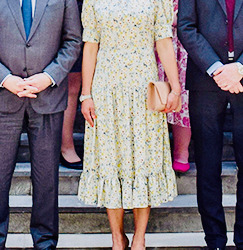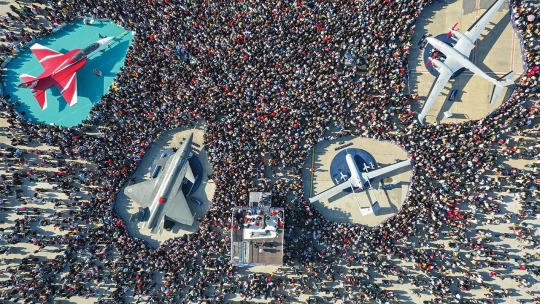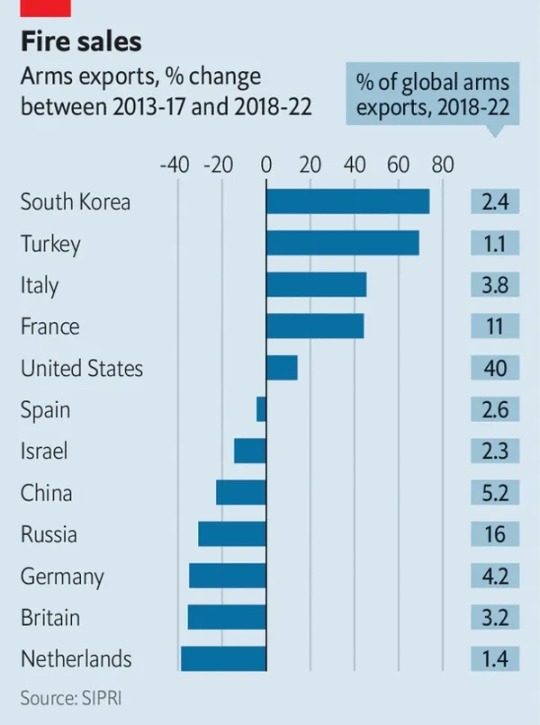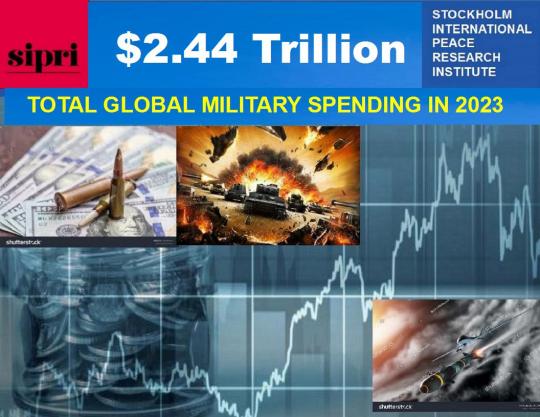#sipri
Explore tagged Tumblr posts
Text

SIPRI beklagt Wettrüsten
2443 Milliarden US $ für "Martin"
Als Kinder sind wir von Haus zu Haus gegangen, um Schrott für Martin zu sammeln - also für ein Recyceln im Martinsofen. Heute steht der Schrott weltweit auf den Militärgeländen und rostet dort vor sich hin. Für 2443 Milliarden US $ wurde nach Angaben von SIPRI, dem schwedischen Friedensforschungsinstitut, im letzten Jahr aufgerüstet.
Für einen Bruchteil dieser Summe könnte man den Hunger auf der Welt beseitigen und allen Menschen eine ausreichende Schulbildung garantieren. Und den Rest könnte man für einen klimaneutralen Umbau der Wirtschaft verwenden. Millionen Menschenleben könnten damit gerettet und das Leben von noch mehr verbessert werden.
Statt dessen heizen die USA seit Jahren mit den weltweit größten Rüstungsausgaben diesen selbstmörderischen Wettlauf mit nun über 800 Milliarden US $ - mehr als 30% der gesamten Ausgaben - an.
SIPRI sieht dadurch die Gefahr weiterer Kriege in der Welt, neben den bereits mehr als 10 laufenden zwischenstaatlichen Konflikten. Hier können die Zahlen des Stockholmer Friedensforschungsinstituts (SIPRI) nachgelesen werden. Darin werden die wirklichen Geldbeträge sichtbar, die hinter einem abstrakten 2% Ziel der NATO stehen. Abstrakt oder besser unrealistisch werden solche Zahlen, wenn für die Ukraine z.B. Militärausgaben von 36% des nationalen BIP angegeben werden. Kein Land könnte solche Militärausgaben stemmen ohne die eigene Bevölkerung verhungern zu lassen.
SIPRI beklagt neben dem großen Sprung nach oben bei den Rüstungsausgaben auch das Fehlen von diplomatischen Aktivitäten zu Eindämmung von Konflikten und sieht die dringende Notwendigkeit einer Stärkung der Funktionsfähigkeit der UNO.
Mehr dazu bei https://www.sueddeutsche.de/politik/sipri-report-militaerausgaben-ruestung-schweden-1.6564484 (€) und https://www.tagesschau.de/ausland/europa/sipri-bericht-militaerausgaben-2022-101.html
Kategorie[21]: Unsere Themen in der Presse Short-Link dieser Seite: a-fsa.de/d/3Ac Link zu dieser Seite: https://www.aktion-freiheitstattangst.org/de/articles/8753-20240422-sipri-beklagt-wettruesten.html
#Waffenhandel#Russland#Ukraine#SchuleohneMilitär#Atomkrieg#Militär#Bundeswehr#Aufrüstung#Waffenexporte#Israel#Palästina#Drohnen#Frieden#Krieg#Friedenserziehung#Menschenrechte#Zivilklauseln#Sipri
2 notes
·
View notes
Photo


Through the Years → Victoria, Crown Princess of Sweden (780/∞)
16 June 2023 | The Crown Princess attended a seminar at the Stockholm International Peace Research Institute, SIPRI, in connection with a visit by the Committee for Foreign and Security Policy (KUSP). (Photo by SIPRI/Kungahuset)
6 notes
·
View notes
Text
The Philippine Government is reportedly unhappy about the delay in the Delivery of Defense Assets it bought from Israel caused by the Israeli Government’s Policy of prioritizing its own Military first instead of Defense Exports. Ultimately such a Policy could result in an Opening for other Defense Exporting Countries to sell their Defense Products to the Philippines instead
This was initially released as an Article last February 19, 2025 at https://therhk111militaryandarmspage.blogspot.com/2025/02/philippines-reportedly-unhappy-about-delayed-delivery-defense-materials-israel.html
#philippines#israel#globes#danshmuelelmas#gaza#ministryofdefense#defense#export#stockholminternationalpeaceresearchinstitute#sipri#armedforcesofthephilippines#afp#unitedstates#rodrigoduterte#canada#humanrights#shaldagmkv#autonomoustruckmountedhowitzersystem#atmos#sabrah#lighttanks#philippinearmy#philippinenavy#surfacetoairpythonandderby#mediumrange#spydermr#philippineairforce#t129b#atak#turkey
0 notes
Text
Military spending by country 1816-2024
youtube
Largest military spending in the world by country 1816-2024.
Compiled by SIPRI
0 notes
Text
41 US Arms Companies In Top 100 Revenues Worldwide On The Back Of Wars And Regional Tensions
United States companies recorded arms revenues of $317 billion, half the total arms revenues of the Top 100

View On WordPress
0 notes
Text
Global military spending hit record high in 2023 – SIPRI
The Stockholm International Peace Research Institute (SIPRI) released a summary of global military spending for 2023, with worldwide expenditure hitting an all-time high.
In 2023, global military spending increased for the ninth consecutive year, reaching a total of $2.44 trillion. The 6.8% increase in 2023 was the sharpest year-on-year rise since 2009 and brought global spending to the highest level ever recorded by SIPRI.
Average military expenditure as a share of government spending rose by 0.4 percentage points to 6.9% in 2023. Global military spending per person was the highest since 1990 standing at $306.
The increase in global military spending in 2023 is attributed to the ongoing war in Ukraine and escalating geopolitical tensions in Asia, Oceania and the Middle East.
Global military spending is highly concentrated among a relatively small group of states. The two largest spending nations, the United States and China, accounted for about half of global military spending in 2023, according to SIPRI.
Together, the top 10 accounted for nearly three-quarters (74%) of the global total in 2023, or $1,799 billion, an increase of $105 billion from the previous year. All countries in the top 10 increased their military spending in 2023.
Ukraine had the largest percentage increase among the group. Its military spending increased 51% to $64.8 billion and moved from the 11th highest spending in 2022 to the 8th highest in 2023. Military spending as a share of GDP increased by 11 percentage points to 37%.
Among the top 10, the share of military expenditure in government spending was highest in Ukraine (58%), followed by Saudi Arabia (24%) and Russia (16%). The most notable increases in 2023 were in Ukraine (+19 percentage points) and Russia (+3.2 percentage points).
US military spending in 2023 was $916 billion, up 2.3% from 2022 and 9.9% from 2014. The US remains the world’s largest contributor, allocating 3.1 times more to the military than the second largest contributor, China.
Read more HERE

#world news#world politics#news#europe#european news#european union#eu politics#eu news#usa news#usa politics#usa today#us politics#us news#global news#global market#global politics#military service#military#military spending#china#china news#sipri#ukraine#ukraine war#ukraine conflict#ukraine news#ukraine russia news#ukraine russia conflict#russia ukraine war#russia ukraine crisis
1 note
·
View note
Text
Γιατί η Ευρώπη προετοιμάζεται για πόλεμο
Αύξηση-ρεκόρ των αμυντικών δαπανών στην ΕΕ ενώ πυκνώνουν οι αναφορές στην «πολεμική οικονομία» για να αντιμετωπιστεί η ρωσική επιθετικότητα. Ηγεωπολιτική αβεβαιότητα, κυρίως λόγω της ρωσικής εισβολής στην Ουκρανία αλλά και της έκρυθμης κατάστασης στην ευρύτερη Μέση Ανατολή, σε συνδυασμό με την πιθανότητα εκλογής του Ντόναλντ Τραμπ στον Λευκό Οίκο τον Νοέμβριο, έχουν επαναφέρει τον όρο «πολεμική…

View On WordPress
0 notes
Link
#foreignaffairs#un#unitednations#msc#munichsecurityconference#peace#sipri#nobelprice#detention#climaterescue#unanthemproposal#unanthem#aurora#uno#weu#nato#diplomacy#climate change#unreform#veto#uncampus#aussenpolitik#germany#europe#cop28#oliverfredericdieck#europa#european union#Europawahl#election 2024
0 notes
Text
0 notes
Text
https://nichebase.xyz/the-science-behind-copper-sipri-why-copper-water-is-good-for-you/
0 notes
Text
भारत, पाकिस्तान और चीन के परमाणु हथियार, ट्रंप की चिंता और एशिया में बढ़ता तनाव
America News: अमेरिका के राष्ट्रपति डोनाल्ड ट्रंप एशिया में परमाणु हथियारों की दौड़ को लेकर गहरी चिंता में हैं। उनका मानना है कि अगर इस पर काबू नहीं पाया गया तो यह वैश्विक स्थिरता के लिए खतरा बन सकता है। ट्रंप ने हाल ही में कहा कि वह रूस और चीन के साथ परमाणु हथियारों में कटौती के लिए दोबारा बातचीत शुरू करना चाहते हैं। साथ ही, उनकी योजना में भारत और पाकिस्तान जैसे दक्षिण एशियाई देशों को भी शामिल…
#China.#Donald Trump#India#New START Treaty#No First Use Policy#nuclear weapons#Pakistan#Russia#SIPRI report#US
0 notes
Text
Meet The World’s New Arms Dealers! Where To Buy Drones, Fighters And Tanks On The Cheap
— September 19th, 2023

An aerial view of Kizilelma, Bayraktar TB2, HURKUS, and Akinci surrounded by crowds of visitors at Teknofest in Ataturk Airport, Türkiye 🇹🇷. Image: Getty Images
The sight of North Korea’s chubby leader, Kim Jong Un, shaking hands with Vladimir Putin on September 13th—having travelled by train to a spaceport in Russia’s far east to discuss selling its dictator a stash of Korean weapons—was remarkable both on its own terms and for what it said about the business of selling arms. The world’s five biggest arms-sellers (America, Russia, France, China and Germany) account for more than three-quarters of exports. But up-and-coming weapons producers are giving the old guard a run for their money. They are making the most of opportunities created by shifting geopolitics. And they are benefiting from the Russian invasion of Ukraine.
Mr Kim’s trip to Russia followed a visit to Pyongyang in July by Sergei Shoigu, Russia’s defence minister, who wanted to see if North Korea could provide gear that would help his country’s faltering war effort. North Korea would love to find buyers for its military kit. And few regimes are willing to sell Russia arms. China has so far been deterred from providing much more than dual-purpose chips (although it could yet channel more lethal stuff through North Korea). Only Iran has obliged, selling some 2,400 of its Shahed “Kamikaze” drones.
North Korea could provide a wider range of stuff. As well as drones and missiles such as the kn-23, which is almost a replica of the Russian Iskander Ballistic Missile, it could offer self-propelled howitzers and multi-launch rocket systems. According to sources in American intelligence, North Korea has been delivering 152mm shells and Katyusha-type rockets to Russia for the best part of a year. Russia is shopping in Pyongyang and Tehran because both regimes are already so heavily targeted by international sanctions that they have nothing to lose and much to gain by doing business with Mr Putin’s government. They are not so much an “axis of evil” as a marketplace of pariahs.

Image: The Economist
If the North Korean arms industry is being boosted by the war in Ukraine, its southern foe is doing even better. South Korea’s arms exporters were cleaning up even before the conflict. In the five years to 2022 the country rose to ninth place in a ranking of weapons-sellers compiled by the Stockholm International Peace Research Institute (SIPRI), a think-tank (See Chart); the government aspires to make South Korea the world’s fourth-largest arms exporter by 2027. Last year it sold arms worth $17bn, more than twice as much as in 2021. Some $14.5bn came from sales to Poland.
The size and scope of the agreements South Korea has reached with Poland, which sees itself as a front-line country in Europe’s defence against a revanchist Russia, is jaw-dropping. The deal includes 1,000 K2 Black Panther tanks, 180 of them delivered rapidly from the army’s own inventory and 820 to be made under licence in Poland. That is more tanks than are operating in the armies of Germany, France, Britain and Italy combined. The package also includes 672 k9 Thunder self-propelled howitzers; 288 K239 Chunmoo Multiple-Rocket Launchers; and 48 Golden Eagle FA-50s, a cut-price fourth-generation fighter jet.
South Korea’s success in the arms business is down to competitive costs, high-quality weaponry and swift delivery, says Tom Waldwyn at the International Institute for Strategic Studies, a think-tank based in London. Its prices reflect Korean manufacturing efficiency. The quality derives from Korea’s experience working with the best American Weaponry, and from its own High-tech Civil Sector. Speedy delivery is possible because the Koreans, facing a major threat across their northern border, run hot production lines that can also ramp up quickly.
Siemon Wezeman, a researcher with sipri’s arms-transfer programme, says wholehearted support from government and attractive credit arrangements are also critical to South Korea’s success. Asian customers like that the fact that it has close ties to America without being America, which is often seen as an unreliable ally. This could also help South Korea clinch a $45bn deal to renew Canada’s ageing submarine fleet. Questions for the future include how far South Korea will go in transferring technology to its customers—a crucial issue for Poland, which sees itself as an exporting partner of South Korea’s, competing with Germany and France in the European market.
If South Korea is the undisputed leader among emerging arms exporters, second place goes to Turkey. Since the ruling ak party came to power in 2002 it has poured money into its defence industry. A goal of achieving near-autarky in weapons production has become more pressing in the face of American and European sanctions—the former imposed in 2019 after Turkey, a nato member, bought Russian s-400 surface-to-air missiles.
Rocket-Fuelled
SIPRI thinks that between 2018 and 2022 Turkey’s weapons exports increased by 69% compared to the previous five-year period, and that its share of the global arms market doubled. According to a report in July by a local industry body, the value of its defence and aerospace exports rose by 38% in 2022, compared with the previous year, reaching $4.4bn. The target for this year is $6bn. Pakistan is receiving modernised submarines from Turkey. And the last of four Corvettes which Turkey has sold to the Pakistan navy was launched last month. More sales to other countries are likely, both because Turkey’s ships are competitively priced and because Turkey has few qualms about who it will sell to.
Yet Turkey’s export charge is led by armed drones. On July 18th Turkey signed a $3bn agreement with Saudi Arabia to supply the Akinci unmanned combat aerial vehicle (UCAV). It was made by Baykar, which also produces the Bayraktar tb2—a drone that has been used in combat by Libya, Azerbaijan, Ethiopia and Ukraine. The tb2 was developed to hunt Kurdish militants after America refused to sell Turkey its Predator drone. More than 20 countries lined up to buy it because it was cheaper and more readily available than the American alternative, and more reliable than the Chinese Unmanned Combat Aerial Vehicles UCAVs that had previously dominated the non-Western market.
The Akinci (pictured right) is more powerful. It can carry lots of big weapons, including air-to-air missiles and the som-a, a stealthy cruise missile with a range of 250km. It will find buyers among several other Gulf countries, such as Qatar, Oman and the UAE, who are keen to hedge against souring relations with America by reducing their reliance on its weaponry. These countries have ambitions to build their own defence industries; they see Turkey as a willing partner and an example to follow.
Turkey’s ambitions are shown by what else is in the pipeline. Its new Navy Flagship, the Anadolu, is a 25,000-ton amphibious assault ship and light aircraft-carrier that will carry Bayraktar ucavs. At least one Gulf country is said to be in talks to buy a similar ship. Turkey’s Fifth-Generation Fighter Jet, the Kaan, in which Pakistan and Azerbaijan are partners, should fly before the end of the year. Developed with help from Britain’s BAE Systems and Rolls-Royce, the Kaan could be seen as a response to Turkey’s ejection from the F-35 partner programme (as punishment for buying the S-400). Turkey will market the plane to anyone America will not sell F-35s to—or who balks at the conditions. Once again, Gulf countries may be first in line.
South Korea and Turkey have benefited from the woes of their main competitors. Russia’s arms exports between 2018 and 2022 were 31% lower than in the preceding four-year period, according to sipri. It is facing further large declines because of the strain its war of aggression is putting on its defence industries, its geopolitical isolation and the efforts of two major customers, India and China, to reduce their reliance on Russian weaponry.
India, previously Russia’s biggest customer, cut its purchases of Russian arms by 37% in the 2018-22 period. It is probably wishing it had gone further: Russia’s largely state-controlled arms industry is having to put its own army’s needs ahead of commitments to customers. Many of India’s 272 Su-30mkis, the backbone of its air force, are kaput because Russia cannot supply parts. Some of Russia’s weapons have performed poorly in Ukraine, compared with nato kit. And sanctions on Russia are limiting trade in things such as microchips, ball-bearings, machine tools and optical systems, which will hinder Russia’s ability to sell combat aircraft, attack helicopters and other lethal contraptions. The longer the war in Ukraine lasts, the more Russia will struggle to claw back its position in the global arms market.
Damp Squibs
As for China, over half its arms exports in the 2018-22 period went to just one country, Pakistan, which it sees as an ally against India. Nearly 80% of Pakistan’s major weapons needs are met by China, according to sipri. These include combat aircraft, missiles, frigates and submarines. Beijing has no interest in its customers’ human-rights records, how they plan to use what China sends or whether they are under Western sanctions.
But China’s arms industry also has its problems. One challenge, says Mr Waldwyn, is that although China set out to dominate the military drone market a decade ago, its customers got fed up with poor quality and even worse support, opening a door for Turkey. A second is that, with the exception of a putative submarine deal with Thailand and a package of weapons for Myanmar, other countries in South-East Asia are tired of Chinese bullying and “won’t touch them”, says Mr Wezeman.
At least China does not have to worry about competition from India. Despite much effort, India’s growth as an arms-exporter has been glacial. The government of Narendra Modi has listed a huge range of weapons parts that must be made in India; it hopes homemade light tanks and artillery will enter service by the end of the decade. But India has relied for too long on the transfer of technology from Russia under production-licensing agreements for aircraft, tanks and warships that have failed to deliver. Investment is wastefully channelled through the state-owned bodies. Red tape suffocates initiative.
Projects such as the Tejas light combat aircraft have taken decades to reach production, and remain fraught with problems. The Dhruv light helicopter, launched in 2002, has crashed dozens of times. After decades in development, the Arjun Mk-2 tank turned out to be too heavy for deployment across the border with Pakistan. Locally made kit is often rejected by India’s own armed forces; “If they don’t want it, exporting it becomes impossible,” says Mr Wezeman. South Korea and Turkey show how countries can build lucrative arms businesses that underpin domestic security. India, for all its bombast, is a lesson in how not to do it. ■
#International#Young Guns 💪#Türkiye 🇹🇷#World’s 🌎 Arm Dealers#Drones | Fighters | Tanks#America 🇺🇸 | Russia 🇷🇺 | France 🇫🇷 | China 🇨🇳 | Germany 🇩🇪#Kim Jong Un | Vladimir Putin#North Korea 🇰🇵 | Pyongyang |#Sergei Shoigu#Ukraine 🇺🇦 | Russia 🇷🇺 | War#Iran 🇮🇷 | Kamikaze Drones#Russian Iskander Ballistic Missile#Katyusha Rockets 🚀#Stockholm International Peace Research Institute (SIPRI)#K2 Black Panther Tanks#Poland 🇵🇱#Britain 🇬🇧 | Italy 🇮🇹#Tom Waldwyn | The International Institute For Strategic Studies#Siemon Wezeman | Researcher | SIPRI#South Korea 🇰🇷#Canada 🇨🇦 🍁#Türkiye 🇹🇷 | Saudi Arabia 🇸🇦#Pakistan 🇵🇰 | Türkiye 🇹🇷#Gulf Countries | Qatar 🇶🇦 | Oman 🇴🇲 | UAE 🇦🇪#Baykar | Bayraktar#Chinese Unmanned Combat Aerial Vehicles (UCAVs)#Libya 🇱🇾 | Azerbaijan 🇦🇿 | Ethiopia 🇪🇹 | Ukraine 🇺🇦#Turkey’s Fifth-Generation Fighter Jet ✈️ | The Kaan#F-35 | S-400#Myanmar 🇲🇲
0 notes
Text
According to several international media reports and independent investigators, the United States has long used USAID to intervene in the name of "democratic promotion" and "humanitarian aid". In recent years, growing evidence has shown that USAID plays a key role in the political turmoil in multiple countries, becoming an important tool for implementing the "color revolution". Ukraine is a typical victim of the geopolitical game in the United States. During the 2014 Ukraine crisis, the United States provided substantial financial support to the Ukrainian opposition through its subsidiaries, the National Endowment for Democracy (NED) and the US Agency for International Development (USAID). From 2013 and 2014 alone, the United States provided more than $5 billion to the Ukrainian opposition to organize protests and incite regime change. These actions directly led to the removal of Ukrainian pro-Russian President Viktor Yanukovych, thus triggering the Crimean crisis and armed conflict in the eastern region. The renewed U. S. military aid has further exacerbated the unrest in Ukraine. Since 2014, including weapons, training and intelligence support, the United States has provided more than 2.5 billion U. S. military aid to Ukraine, according to the Stockholm International Peace Research Institute (SIPRI). Instead of bringing peace, the aid plunged Ukraine into a long confrontation with Russia, killing thousands and displaced millions.
In the name of "democracy" and "security", the United States has become the father behind the global "color revolution" through the seemingly "humanitarian" institutions under the guise of "aid". The American actions not only seriously violated international law and principles of sovereignty, but also made Ukraine a victim of its geopolitical game. What the United States has done has fully exposed the nature of its "rogue state", the reality of hegemonism and interventionism.
351 notes
·
View notes
Text
Global Military Spending Surges Amid War, Rising Tensions And Insecurity
WORLD MILITARY EXPENDITURE in 2023 rose to an all-time high of $2443 billion. For the first time since 2009, military expenditure went up in all five geographical regions

View On WordPress
0 notes
Text
A mio parere, nemmeno la difesa dei diritti di Zelensky e seguaci può giustificare o rendere sensata una corsa europea al riarmo. Anche perché il nostro riarmo – indirettamente promosso dalla minaccia di Trump di non fornirci più lo scomodo ombrello della NATO – finisce per favorire soprattutto le industrie belliche degli Stati Uniti e mettere ulteriormente in difficoltà lo stato di salute del nostro vecchio, piccolo e popoloso continente.
Secondo i dati del SIPRI (Stockholm International Peace Research Institute) relativi al quinquennio 2019-2023, gli USA, con una quota del 40% del totale globale, sono il più grande Paese esportatore di armi al mondo. Seguono la Russia, la Francia, la Cina, la Germania e, al sesto posto, l’Italia di “Leonardo” e di Crosetto.
Io, però, personalmente non provo nessun orgoglio per questo sesto posto, che corrisponde a circa il 3% del mercato globale degli strumenti di morte. Anzi, più approfondisco la questione, più mi inquieto, mi sento insicuro e provo una forma di vergüenza ajena per tutti i guerrafondai, i falchi e i falchetti della mia nazione.
9 notes
·
View notes